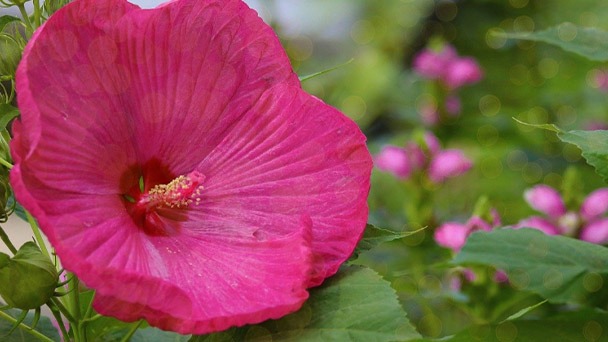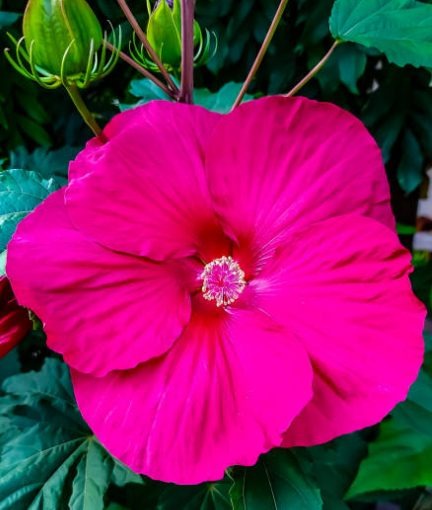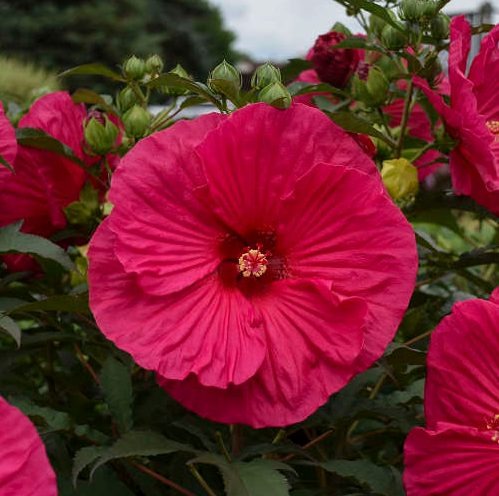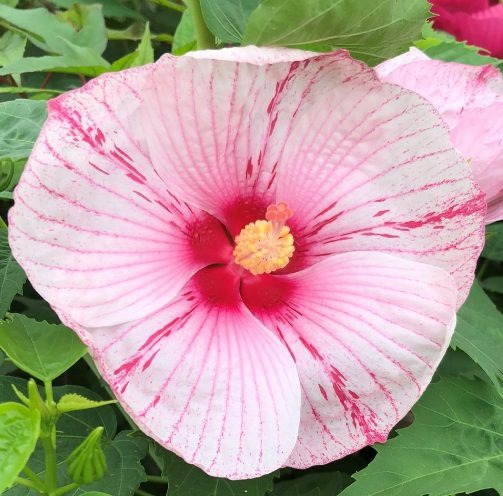How to Grow and Care for Dinner Plate Hibiscus
Written by Ivy
Jan 09 2023

The perennial Hibiscus moscheutos, also known as the Dinner Plate Hibiscus, is cold-tolerant. Landscape designers and gardeners like it because of its large, vibrant blooms.
In the eastern United States, wetland along rivers is where it originally evolved. It can endure as far north as southern Ontario in Canada and can be found as far west and south as Texas. Learn how to take care of a dinner plate hibiscus in the following paragraphs, including how to plant the seeds and how much water to provide.
How to Identify Dinner Plate Hibiscus

Hibiscus moscheutos' most alluring feature is its enormous flowers, which are guaranteed to catch your eye and inspire your imagination. White, pink, and red are among the colors of these large, open flowers.
The common names for this hibiscus can very well describe it:
- Hardy hibiscus
- Perennial hibiscus
- Herbaceous hibiscus
- Giant hibiscus
- Rose mallow
- Swamp rose mallow
The Malvaceae family of flowering plants, which has more than 240 genera and more than 4,200 species, is where the dinner plate hibiscus is classified as a member of the family. This family also includes hollyhock and other mallows, as well as cacao, cotton, okra, and durian.
Perennial in nature, this plant sheds its ovate leaves in the fall before regrowing late in the spring or early in the summer. The dinner plate hibiscus is a cold-hardy plant that can survive in USDA zones 5 to 8, and it can even survive in Canada. It is commonly found in wetlands or along riverbanks in the eastern United States.
The smooth, grayish-green, toothed leaves can vary in texture. The dinner plate hibiscus is typically grown for its one-day-long blooms.
However, one plant can produce numerous blooms throughout a month, giving you a good amount of color to enjoy. The flowers typically have five overlapping petals and range in size from four to twelve inches (10.2 to 30.5 centimeters).
The flowers typically have a red center with a white exterior. Rarely do you encounter a pure colored bloom, such as a pure white, pink, or red hue. This plant has a range of heights between four and seven feet (1.2 to 2.1 meters) and a spread of three to four feet.
The dinner plate hibiscus can draw pollinators, butterflies, and other wildlife into your garden. This long-blooming, deer-resistant plant can make a wonderful centerpiece for your yard and rain garden. It can be planted in areas with more moisture.
At a Glance
| Common Name | Hardy hibiscus, rose mallow, swamp rose mallow |
| Botanical Name | Hibiscus moscheutos |
| Family | Malvaceae |
| Plant Type | Herbaceous perennial |
| Mature Size | 3–7 ft. tall, 2–4 ft. wide |
| Sun Exposure | Full sun |
| Soil Type | Average, organically rich |
| Soil pH | Neutral to slightly acidic |
| Bloom Time | Summer |
| Flower Color | White, red, pink, blue |
| Hardiness Zones | 4–9 (USDA) |
| Native Area | North America (Missouri) |
Dinner Plate Hibiscus Care
Light
In order to thrive, develop the proper coloring, and bloom, perennial hibiscus needs an abundance of sunlight. Where the sun shines continuously is where you should plant your new hibiscus. Those grown for their dinner plate-sized blooms as well as their dark purple foliage require full sun (6+ hours), which is especially crucial. Plants grown in shade will have leaves that are more a green color because the purple coloring is a reaction to UV light from the sun.
Hibiscus receives energy from the sun to develop its flower buds. Hibiscus should be grown in full sun, regardless of where you live, to get the most out of its flowering potential. If growing it in part sun is your only option, make sure it receives at least a few hours of warm afternoon sun.
Water
Hibiscus plants that are perennials have a high water requirement. They can flourish in shallow water and along streambanks in their natural habitat. Humidity is also ideal for them. This perennial is not the best choice for your garden if you live in a dry climate.
Plant your perennial hibiscus in a location where it will receive regular irrigation from an automatic sprinkler system. Plant your garden close to your hose if you hand-water it to make it simple to give it a drink frequently. Keep the soil from drying out too much, especially if you have clay because dry clay can become very hard. To help plants retain moisture, add compost to the soil before planting, and mulch the area around the plants.
You know your perennial hibiscus is not getting enough water if:
- The whole plant is drooping
- The flower buds are turning yellow and falling off before they open
- The leaves start to turn fall colors well before that season has arrived
Potting & Soil
A dinner plate hibiscus typically grows in marshes and wetlands in the wild. So, if you're looking for a spot for your plant, look for a damp area.
It's actually a good thing because not all plants prefer soil that is consistently moist or wet. Around ponds and other water features, you can also plant dinner plate hibiscus. You might want to think about purchasing a self-watering planter because your dinner plate hibiscus prefers its soil to be moist.
A fertile soil is also essential. You should add a lot of compost to the soil if you believe this will be an issue.
Space
When perennial hibiscus completely dies back to the ground in the fall, some people are shocked. They presume a plant this size is a woody shrub, but it is actually a perennial herb. As a result, the plant loses its leaves in the late fall and grows new leaves the following spring from the roots.
Approximately 3 to 6 feet tall, perennial hibiscus typically grow wider than they do tall. Additionally, they develop quickly. Don't fall for the fallacy that if you start with a small plant, you can temporarily plant it somewhere and then move it later. After just one or two years, it will be challenging to transplant due to its extensive root system.
A better plan would be to place your new hibiscus somewhere where it will have plenty of space to develop over the following few years. As it grows, fill in the area around it with vibrant annuals. Less annuals will be required each year to cover the surrounding area. Your perennial hibiscus will be nearly mature by the end of the third year.
Pruning
Perennial hibiscus needs all of the old, woody stalks removed every spring to make room for the new growth. In this video, you can see how the new growth breaks through the soil. This perennial, like any other herbaceous perennial, resprouts all new growth every year; no new foliage will grow from last year's stems.
The center of a perennial hibiscus stem is hollow, as you can see if you look closely at this image.
When the plant is not actively growing, rain and snow can enter the hollow stems and cause rot or the plant's crown to freeze and thaw. Because of this, we advise cutting the plant down in the spring rather than the fall.
To reduce the stalks to a height of approximately 6 to 8 inches, use a hand saw, a good pair of loppers, or pruners. As a result, the plant's crown will be exposed to the sun, encouraging new growth.
Throughout the season, no additional pruning should be required or advised. Do not cut the stems of your perennial hibiscus if it becomes taller than you would like it to be because doing so will destroy the flowers. Moving it somewhere where its full size will be appreciated should wait until the following spring.
Fertilizer
Hefty feeders include dinner plate hibiscus. In general, you must fertilize your dinner plate hibiscus with liquid fertilizer once a week. You can also apply a slow-release fertilizer that you'd need to apply:
- Early spring
- After the plant first blooms for the year
- Mid-summer
- Early winter
There are some fertilizers made specifically for hibiscus plants. These products make it impossible to guess how much phosphorus, potassium, and nitrogen you'd need to keep your plant healthy.
Temperature and Humidity
Temperatures between 65 and 75 degrees Fahrenheit are ideal for the blooming of hibiscus plants. Bring indoor plants before it gets below 32 degrees Fahrenheit, but be careful because low humidity can cause them to dry out very quickly. You'll need to mist the leaves of your hardy hibiscus every day if you bring them inside for the winter, or you can put each pot on a pebble tray with water. The humidity will increase around the plant as the water evaporation continues. Increased humidity in your home is another benefit of a small space humidifier.
Pests
Perennial hibiscus is a member of the rose family botanically, and Japanese beetles like to attend the annual family reunion just like they do with roses. If this pest is a problem in your area, the best long-term solution is to treat your lawn for it when it is in the grub stage. One of the best treatments is milky spore, but it takes a while for it to be effective. A bucket of soapy water can be used to effectively remove the beetles in the interim.
Additionally, keep an eye out for hibiscus sawfly larvae, which in their juvenile stage resemble small green worms. They chew holes in the leaves, occasionally quite extensively, similar to Japanese beetles. For sawfly larvae, systemic insecticides work well.

Does Hibiscus Moscheutos Need Special Grooming Or Maintenance?
The old woody stems from the previous year should be clipped with a pair of clippers to a height of 6″ inches in the spring when new growth starts to appear, and then discarded.
Instead of coming from the old stems, new growth comes from the ground.
It is neater to deadhead or remove spent blooms from dinner plate hibiscus plants as they bloom and fade.
This is not necessary for the plant to continue blooming. Old blooms, on the other hand, are messy and can be cut off to make the plant look nicer.
How to Plant Dinner Plate Hibiscus
Many gardeners prefer the dinner plate hibiscus to grow in their gardens. When the plant goes into dormancy in the winter, you can start it from seeds or crown divisions.
Stem cutting is another option, though success is not guaranteed. The dinner plate hibiscus can be planted in more wet areas of your yard, making it a great option if you have bogs or rain gardens. To give these plants enough room to grow, place them about three to six feet (1.8 meters) apart when you are planting.
How to Propagate Dinner Plate Hibiscus?
You can divide a mature moscheutoss hibiscus. The plant doesn't require division very frequently.
The best time to divide or propagate dinner plate hibiscus is in the early fall, while the plant is still growing above ground and establishing its root systems.
The plant will have time to recover as a result before winter arrives.
Here's what to do:
- Trim back the woody stems to 6″ inches, and remove the plant as though you were about to transplant it.
- Wash any excess soil from the roots, and avoid damaging the main root ball.
- Disinfect a knife in a solution of water and bleach.
- Cut the root ball into two approximately equal halves. Hibiscus plants are generally easy to divide in half.
- Place the plants in their new homes by digging holes like those described for transplants above.
How to Grow Dinner Plate Hibiscus from Seed
The large flowers of your dinner plate hibiscus are definitely worth the extra work, even though growing them from seed is not as simple as planting them in the ground. These seeds germinate slowly and methodically. Before spring arrives, you may want to get a head start by germinating indoors. Two to three months prior to the last frost in your area, you can begin. Here's how you do just that:
1. Use a sharp knife to slice the seed coating's round end. This will enable moisture to reach the seeds and hasten the germination process.
2. Give the seeds a maximum of eight hours of water soaking. Ensure that the water is at room temperature.
3. Put a seed starting mix such as In a container or pot, use fertile garden soil or Purple Cow Organics Seed Starter Mix.
4. Into the prepared pots, add the soaked seeds. They should be buried in the soil or potting mix for about 0.25 inches (7.6 centimeters) deep. Put your seeds and container somewhere that can receive a lot of sunlight and temperatures between 24 and 29 degrees Celsius (75 to 85 degrees Fahrenheit).
5. Wait about two to three weeks for your dinner plate hibiscus seedlings to break through the soil.
6. When larger pots are needed, transfer these into them. As seedlings, they have very brittle stems, so take extra care when transplanting them.
7. Take your new seedlings outside for a few hours each day to acclimate them to the environment. The young plants ought to have a few true leaves. Equally important, make sure there is no chance of frost and that it's warmer outside.
8. When the time comes to move it, find the ideal spot for your dinner plate hibiscus. Make a hole big enough to fit the root ball, then dig around it to get the ground around it loose. Make sure the root ball's top is level with the soil's surface when you plant it.
9. Soak the soil in the hole halfway. This will give your new plant access to all the moisture it needs to flourish.
10. Without burying the top of the root ball, completely fill the hole. After that, re-soak the entire area.
Hibiscus Moscheutos Pests and Diseases
Crown rot affects dinner plate hibiscus occasionally in regions with wet winters.
You might wait until the spring to remove the old growth to give the plant's underground portion some protection from the winter in order to avoid crown rot.
The leaves of Hibiscus moscheutos can occasionally develop fungus issues such as Hibiscus rust, leaf spot, and blight.
Throughout the growing season, make routine checks on the plant and remove any leaves that are sickly.
Instead of adding them to the compost pile, these should be completely thrown away or burned where it is permitted. Some issues can also be resolved with a fungicide.
Suggested Dinner Plate Hibiscus Uses
This variety of hibiscus needs a lot of room as it gets quite tall. It will dominate nearby perennials in a competition.
The dinner-plate hibiscus grows best as a centerpiece plant or in locations that emphasize verticality, like a foundation or fence.
Given its affinity for water, it might be a great plant to place next to a water feature, such as a pond or creek, if there is one flowing on your property.
The sidewalk leading to a house, for example, can be marked by a pair or a row of them.
Best Companion Plantings for Your Dinner Plate Hibiscus
You want a plant that requires the same level of maintenance as your dinner plate hibiscus when selecting companion plants. This prevents accidental plant killing while taking care of the other.
Finding plants that can enhance the appearance of your hibiscus is also beneficial. Consider choosing a flowering plant that can compete for attention with the enormous blooms of the dinner plate hibiscus. Or those with a different blooming season, keeping your garden vibrant and alive with flowers.
Helenium
The same maintenance requirements apply to your hibiscus and helenium autumnale. It prefers a rich, moist soil and does best in full sun.
These plants can grow anywhere from two to five feet (61 to 152.4 centimeters), making them a suitable partner for your dinner plate hibiscus. As well as offering a striking contrast to your hibiscus blooms, the gold, brown, orange, yellow, and red flowers can be found in many gardens.
Swamp Sunflower
In full sun to light shade, Helianthus angustifolius thrives. This means you can plant it next to your dinner plate hibiscus and your swamp sunflower won't object if the hibiscus overtakes it. Swamp sunflowers also prefer moist soil and moderate to heavy irrigation. It requires little upkeep as well.
Its golden yellow flowers bloom in the late summer and into the fall, and it can grow as tall as six feet (1.8 meters).
Switch Grass
Panicum virgatum may sound strange, but this tall grass is both a decorative element in many gardens and a source of food for cattle. This hardy grass can be used to add height to your landscape or simply to create a pleasing contrast with your hibiscus' vibrant flowers.
This can tolerate dry or wet soil and thrive in sandy, moist, or clay environments. Under full sun to partial shade, it can grow as tall as six feet (1.8 meters). Along with pink-tinged, teardrop-shaped flowers, switchgrass also has green leaves.
St John's Wort
Bright yellow and showy flowers are produced by Hypericum prolificum. The height of this shrub can easily reach five feet (1.5 meters).
St. John's wort requires very little maintenance; all it requires is full sun or some shade, a small amount of water, and protection from rotting roots. This plant is probably capable of serving as a temporary hedge or as a remedy for wounds.
Winged Loosestrife
Another tough perennial, Lythrum alatum can reach heights of two to five feet (0.6 to 1.5 meters). Its spiked flowers range in color from pink to purple-red. The winged loosestrife is very simple to grow and prefers full sun, wet or moist soil, just like your hibiscus does.

Types of Hardy Hibiscus
Some of the most common hardy hibiscus plants vary in size and blooms:
- Hibiscus moscheutos 'Lady Baltimore': This variety grows 4 to 5 feet tall and up to 3 feet wide. It has flowers that are pale pink with red centers.
- Hibiscus moscheutos 'Robert Fleming': At maturity, this small-growing variety is between two and three feet tall and wide. Huge, velvety red blooms cover it.
- Hibiscus moscheutos 'Summerific Perfect Storm': Dark purple foliage is produced by this compact, well-branched variety, which can reach heights of 3 feet and widths of 4 feet. The large, whitish-pink, 7-inch flowers on it have a red eye.
Overwintering
Your hardy hibiscus will prosper all through the year if you live somewhere with mild winters and summers. However, if you reside in a region where winter temperatures drop below freezing, you must protect your plants. Hardy hibiscus that is rooted in the ground should be covered with a heavy cloth (burlap) or tarp to survive the winter. The substance must be able to withstand cold, frosty weather. If your hardy hibiscus is potted outside, you can bring it inside, but it will need to stay in temperatures of about 55 degrees Fahrenheit and in about three to four hours of direct full sun each day to survive.
Where to Buy Dinner Plate Hibiscus Seeds Online
Dinner plate hibiscus seeds are sold by a number of Etsy vendors. If you want to acquire the seeds for several dinner plate hibiscus varieties, visit Florida Seed Shack. If not, you can simply search for these seeds to find more choices.
You can find more dinner plate hibiscus seeds from these retailers:
- Amazon
- eBay
- Burpee
Conclusion
To successfully grow dinner plate hibiscus, you need water and sunlight. With 16 hours of sunlight each day, they develop their ideal plant mass and flowering. When growth begins in the spring, apply a general-purpose slow-release fertilizer. Add a rose fertilizer—or any other fertilizer that will encourage the growth of flowers—six to eight weeks later to help the plant produce flowers all summer long.
FAQs
Are Hibiscus Plants Poisonous?
Hibiscus is generally safe for people to consume. The flowers are sometimes used as garnishing for various dishes or in the brewing of tea.However, despite having some bitterness even after being swallowed, these flowers are not particularly appetizing. The leaves are bland.
Additionally, there are some alleged medicinal uses for hibiscus in general. In the past, it was employed to treat dysentery as well as lung and urinary conditions.
What's the Difference Between a Hardy and a Tropical Hibiscus Plant?
Hardy and tropical hibiscus are the two varieties. Although it naturally dies back to the ground while dormant in the cold weather, hardy hibiscus typically survives outdoor winters. For the winter, tropical hibiscus must be brought inside.
Can Hardy Hibiscus Grow in Partial Shade?
Although the plant can be grown in some shade, it probably won't bloom very well. To produce blooms, it needs the sun. If the plant is rooted in the ground and cannot be moved, try to remove any obstructions that might prevent it from receiving sunlight. The blooms can grow even for just one or two hours per day.
Can Hardy Hibiscus Be Grown Indoors as a Houseplant?
Hardy hibiscus are best left outside, though many tropical hibiscus plants can be grown indoors as houseplants. One reason is that it can get out of hand when grown indoors, and if not placed in direct sunlight, it won't even bloom.
Latest Updated
- Benefits of Bugleweed - 7 Science-backed Health Benefits
- Bugleweed Dangers & Side Effects - Is It Poisonous?
- How to Plant Evergreen Trees - What You Should Know
- When to Plant Evergreens - Grow Guide for Evergreen Trees
- 12 Wonderful Evergreen Shrubs for Your Garden
- 12 Popular Evergreen Plants with Pictures for Beginners
- When And How To Prune A Lilac Bush Like a Pro
- How to Grow & Care for Lilac Vine (Hardenbergia Violacea)
- Japanese Lilac Tree (Syringa Reticulata) Care & Propagation Guide
- Shumard Oak Pros and Cons - What to Know
Popular Articles
- Winter maintenance of Antirrhinum Majus
- How to Grow Terminalia Mantaly Tree
- How to Grow and Care for Crossostephium Chinense
- How to grow Antirrhinum Majus in spring
- Peristeria Elata (Dove Orchid) Profile: Info & Care Guide
- Underwatered Snake Plant (Sansevieria Trifasciata) - Signs And How To Fix
- How to Care for Brazilian Jasmine Plant (Mandevilla Sanderi)
- How to Grow & Care for Graptopetalum Purple Delight in Summer
- Rosa Chinensis (China Rose): Plant Growing & Care Tips
- How to Care for Baby Sun Rose (Aptenia Cordifolia)